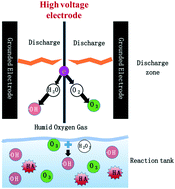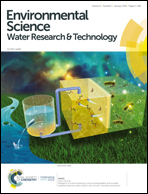Humic acid removal by gas–liquid interface discharge plasma: performance, mechanism and comparison to ozonation†
Abstract
The removal of natural organic matter (NOM) is a major objective for drinking water treatment. In this study, a novel advanced oxidation process (AOP) based on plasma in gas–liquid interface discharge was investigated for removing humic acid (HA), and ozonation treatment effect was evaluated as a comparison. Several indexes including UV254, dissolved organic carbon (DOC), specific UV absorbance (SUVA), and excitation-emission matrix (EEM) fluorescence spectra were employed to characterize HA transformation. The results showed that typical species including ozone, hydrogen peroxide and HO˙ were produced in the plasma process, which made better removal efficiency than ozonation. Especially, UV254 was removed effectively by 96.5% and 90.3% within 15 min by plasma and ozonation, while DOC was 49.2% and 41.1%, respectively. HO˙ radicals were majorly responsible for the degradation of HA in the plasma process, which were mainly generated via reaction of in situ produced ozone and H2O2 during the discharge process. UV/vis absorbance and EEM results further showed that HA with the large molecular weight fraction was decomposed to small molecular weight fraction. This study indicates that plasma technology has a significant application prospect as a replacement for ozone in drinking water industry.



 Please wait while we load your content...
Please wait while we load your content...